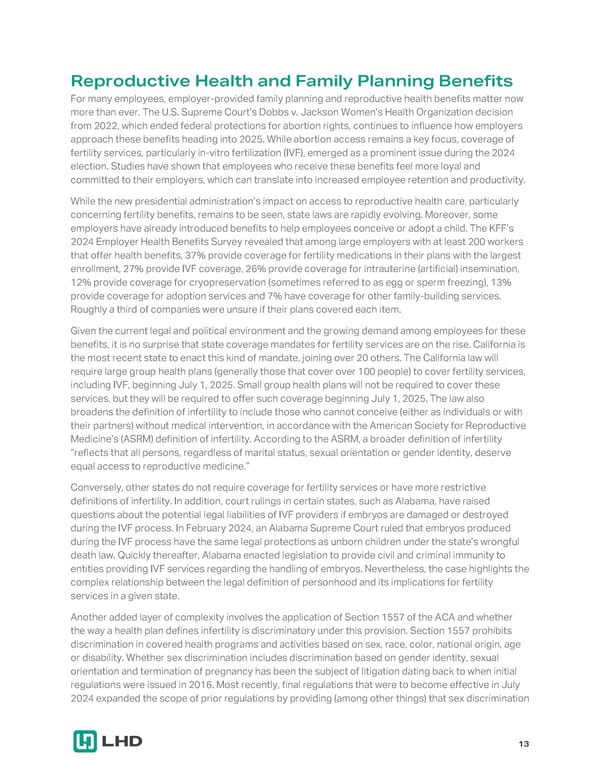Reproductive Health and Family Planning Benefits For many employees, employer-provided family planning and reproductive health benefits matter now more than ever. The U.S. Supreme Court’s Dobbs v. Jackson Women’s Health Organization decision from 2022, which ended federal protections for abortion rights, continues to influence how employers approach these benefits heading into 2025. While abortion access remains a key focus, coverage of fertility services, particularly in-vitro fertilization (IVF), emerged as a prominent issue during the 2024 election. Studies have shown that employees who receive these benefits feel more loyal and committed to their employers, which can translate into increased employee retention and productivity. While the new presidential administration’s impact on access to reproductive health care, particularly concerning fertility benefits, remains to be seen, state laws are rapidly evolving. Moreover, some employers have already introduced benefits to help employees conceive or adopt a child. The KFF’s 2024 Employer Health Benefits Survey revealed that among large employers with at least 200 workers that offer health benefits, 37% provide coverage for fertility medications in their plans with the largest enrollment, 27% provide IVF coverage, 26% provide coverage for intrauterine (artificial) insemination, 12% provide coverage for cryopreservation (sometimes referred to as egg or sperm freezing), 13% provide coverage for adoption services and 7% have coverage for other family-building services. Roughly a third of companies were unsure if their plans covered each item. Given the current legal and political environment and the growing demand among employees for these benefits, it is no surprise that state coverage mandates for fertility services are on the rise. California is the most recent state to enact this kind of mandate, joining over 20 others. The California law will require large group health plans (generally those that cover over 100 people) to cover fertility services, including IVF, beginning July 1, 2025. Small group health plans will not be required to cover these services, but they will be required to offer such coverage beginning July 1, 2025. The law also broadens the definition of infertility to include those who cannot conceive (either as individuals or with their partners) without medical intervention, in accordance with the American Society for Reproductive Medicine’s (ASRM) definition of infertility. According to the ASRM, a broader definition of infertility “reflects that all persons, regardless of marital status, sexual orientation or gender identity, deserve equal access to reproductive medicine.” Conversely, other states do not require coverage for fertility services or have more restrictive definitions of infertility. In addition, court rulings in certain states, such as Alabama, have raised questions about the potential legal liabilities of IVF providers if embryos are damaged or destroyed during the IVF process. In February 2024, an Alabama Supreme Court ruled that embryos produced during the IVF process have the same legal protections as unborn children under the state’s wrongful death law. Quickly thereafter, Alabama enacted legislation to provide civil and criminal immunity to entities providing IVF services regarding the handling of embryos. Nevertheless, the case highlights the complex relationship between the legal definition of personhood and its implications for fertility services in a given state. Another added layer of complexity involves the application of Section 1557 of the ACA and whether the way a health plan defines infertility is discriminatory under this provision. Section 1557 prohibits discrimination in covered health programs and activities based on sex, race, color, national origin, age or disability. Whether sex discrimination includes discrimination based on gender identity, sexual orientation and termination of pregnancy has been the subject of litigation dating back to when initial regulations were issued in 2016. Most recently, final regulations that were to become effective in July 2024 expanded the scope of prior regulations by providing (among other things) that sex discrimination 13
 2025 Employee Benefits Market Outlook Page 12 Page 14
2025 Employee Benefits Market Outlook Page 12 Page 14